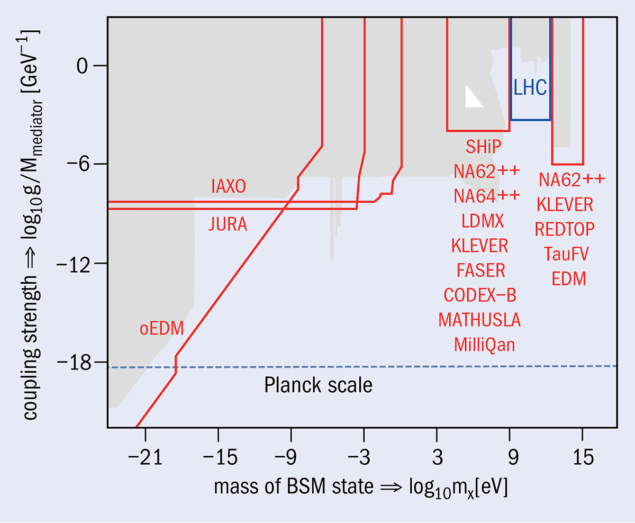
In a workshop held at CERN on 16–17 January, researchers presented the findings of the Physics Beyond Colliders (PBC) initiative, which was launched in 2016 to explore the opportunities at CERN via projects complementary to the LHC and future colliders (CERN Courier November 2016 p28). PBC members have weighed up the potential for such experiments to explore open questions in QCD and the existence of physics beyond the Standard Model (BSM), in particular including searches for signatures of hidden-sector models in which the conjectured dark matter does not couple directly to Standard Model particles.
The BSM and QCD groups of the PBC initiative have developed detailed studies of CERN’s options and compared them to other worldwide possibilities. The results show the international competitiveness of the PBC options.
The Super Proton Synchrotron (SPS) remains a clear attraction, offering the world’s highest-energy beams to fixed-target experiments in the North Area (see Fixed target, striking physics). The SPS high-intensity muon beam could allow a better understanding of the theoretical prediction of the muon anomalous magnetic moment (MUonE project), and a significant contribution to the resolution of the proton radius puzzle by COMPASS(Rp). The NA61 experiment could explore QCD in the interesting region of “criticality”, while upgrades of NA64 and a few months of NA62 operation in beam-dump mode (whereby a target absorbs most of the incident protons and contains most of the particles generated by the primary beam interactions) would explore the hidden-sector parameter space. In the longer term, the KLEVER experiment could probe rare decays of neutral kaons, and NA60 and DIRAC could enhance our understanding of QCD.
A novel North Area proposal is the SPS Beam Dump Facility (BDF). Such a facility could, in the first instance, serve the SHiP experiment, which would perform a comprehensive investigation of the hidden sector with discovery potential in the MeV–GeV mass range, and the TauFV experiment, which would search for forbidden τ decays. The BDF team has made excellent progress with the facility design and is preparing a comprehensive design study report. Options for more novel exploitation of the SPS have also been considered: proton-driven plasma- wakefield acceleration of electrons for a dark-matter experiment (AWAKE++); the acceleration and slow extraction of electrons to light–dark-matter experiments (eSPS); and the production of well-calibrated neutrinos via a muon decay ring (nuSTORM).
Fixed-target studies at the LHC are also considered within PBC, and these could improve our understanding of QCD in regions where it is relevant for new-physics searches at the high-luminosity LHC upgrade. The LHC could also be supplemented with new experiments to search for long-lived particles, and PBC support for a small experiment called FASER has helped pave the way for its installation in the ongoing long shutdown of CERN’s accelerator complex.
2018 was a notable year for the gamma factory, a novel concept that would use the LHC to produce intense gamma-ray beams for precision measurements and searches (CERN Courier November 2017 p7). The team has already demonstrated the acceleration of partially stripped ions in the LHC, and is now working towards a proof-of-principle experiment in the SPS. Meanwhile, the Electric Dipole Moment (CPEDM) collaboration has continued studies, supported by experiments at the COSY synchrotron in Germany (CERN Courier September 2016 p27), towards a prototype storage ring to measure the proton EDM.
The PBC technology team has also been working to leverage CERN’s skills base to novel experiments, for example by exploring synergies across experiments and collaboration in technologies – in particular, concerning light-shining-through-walls experiments and QED vacuum-birefringence measurements.
Finally, some PBC projects are likely to flourish outside CERN: the IAXO axion helioscope, now under consideration at DESY; the proton EDM ring, which could be prototyped at the Jülich laboratory, also in Germany; and the REDTOP experiment devoted to η meson rare decays, for which Fermilab in the US seems better suited.
The PBC groups have submitted their full findings to the European Particle Physics Strategy Update (http://pbc.web.cern.ch/).








